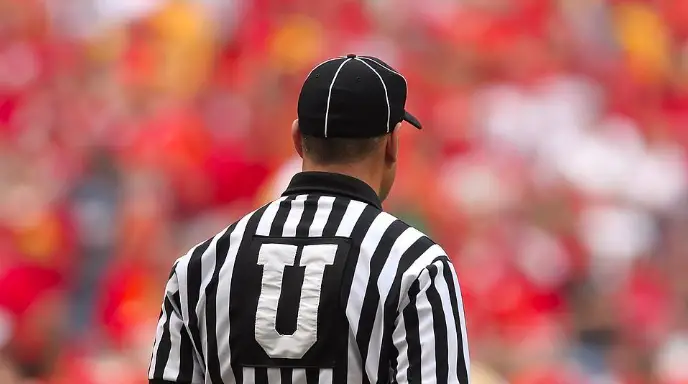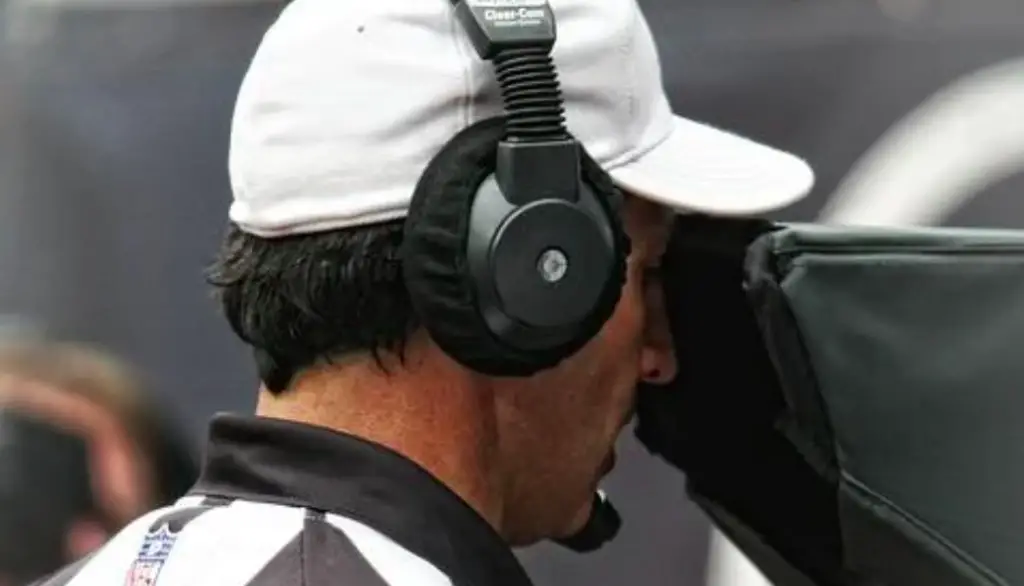Pass interference is an offensive and defensive penalty which occurs when one player significantly interferes with another’s ability to catch the ball.
Generally speaking, this penalty is called when a player stops their opponent from making the catch by contacting them physically.
Maintaining body position or swatting away the ball are legal ways to break up a pass. Contacting the opposing player so he is unable to make a move on the ball is a penalty.
The penalty for offensive pass interference is a loss of ten yards from the previous spot. While the penalty for defensive pass interference is a first down at the spot of the foul.
If you want to learn about other offensive passing penalties read about quarterbacks catching their own passes or the relatively rare illegal usage of the hands penalty.
Defensive pass interference
Defensive pass interference is the much more common of pass interference penalties. Defensive pass interference is often referred to as a DPI.
This penalty can only be called when the ball has been thrown by the quarterback but has not yet been caught.
This is different from offensive pass interference which can be called from the moment the ball is snapped up until the ball is caught.

What a defensive player cannot do in pass coverage
In the NFL rulebook, there are seven different acts which can earn you a defensive pass interference penalty. Though penalties are not limited to just these actions.
- Restricting an opponent’s ability to make the catch while not playing the ball.
- Going through the back of an opponent to make a play on the ball.
- Grabbing an opponent’s arm so they cannot make a catch.
- Extending your arm across the body of an opponent holding them back.
- Cutting off opponent’s path to ball via contact.
- Hooking an opponent causing them to turn.
- Initiating a push or shove against an opponent to earn more separation.
NFL rulebook Section 5 Article 2
If any of these acts are committed by a defensive player after the ball has been thrown then a defensive pass interference penalty should be assessed.
Keep in mind the NFL calls this penalty when the contact significantly hinders a player’s ability to catch the ball. If these acts happen but are relatively minor they will often not be called.
Additionally, the rulebook states that if the officials are questioning whether or not the contact was incidental then the penalty will not be called.
What a defensive player can do
Along with the list of actions that will result in a defensive pass interference penalty the NFL rulebook also states the permissible acts a defender may perform.
There are five different actions the NFL describe which will not result in a defensive pass interference penalty.
- Incidental contact of hands, arms, or body when both players are going for the ball.
- The player’s feet become tangled incidentally
- Contact that would normally be pass interference but the pass is uncatchable
- Laying a hand on an opponent that does not interfere with his ability to catch the ball
- Contact a player who has gained position on an opponent in an attempt to catch the ball
Section 5 Article 3 NFL Rulebook
If any of the acts above are committed a penalty will not be called for DPI. Though these actions may look like interference the rulebook has clarified all of them as legal.
Offensive Pass Interference
Offensive pass interference is a penalty that is called when an offensive player interferes with a defensive player’s ability to catch the ball.
When a pass is thrown in football both the offensive and defensive players have the same right to the ball.
Offensive pass interference penalties can be called from the moment the ball is snapped until the moment it is caught. This is different from defensive pass interference penalties which can only be called when the ball is in the air.
What an offensive player can’t do on passing plays
When determining whether to call an offensive pass interference penalty the officials will use the same reasoning as defensive pass interference.
They will monitor the same seven actions that earn players a defensive pass interference along with one more action that only results in a penalty for the offensive team.
The actions a receiver makes that will result in offensive pass interference are as follows.
- Restricting an opponent’s ability to make the catch while not playing the ball.
- Going through the back of an opponent to make a play on the ball.
- Grabbing an opponent’s arm so they cannot make a catch.
- Extending your arm across the body of an opponent holding them back.
- Cutting off opponent’s path to ball via contact.
- Hooking an opponent causing them to turn.
- Initiating a push or shove against an opponent to earn more separation.
- Blocking a player one yard past the line of scrimmage before a pass is thrown
NFL rulebook Section 5 Article 2
The only act which results in an offensive pass interference and not defensive is when a player blocks an opponent more than one yard down the field before a pass is thrown.
If any of the actions in the list above are committed by an offensive player he will be assessed a OPI penalty.
What an offensive player can do on passing plays
To make things more clear for officials the NFL created a list of actions that are not considered offensive pass interference penalties.
These are the same five permissible acts that are used to determine whether or not a DPI penalty should be called.
The permissible acts for an offensive player include.
- Incidental contact of hands, arms, or body when both players are going for the ball.
- The player’s feet become tangled incidentally
- Contact that would normally be pass interference but the pass in uncatchable
- Laying a hand on an opponent that does not interfere with his ability to catch the ball
- Contact a player who has gained position on an opponent in an attempt to catch the ball
Section 5 Article 3 NFL Rulebook
Pass interference in the endzone
One common question that football fans have when looking at pass interference penalties is what happens when they occur in the endzone.
When a defensive pass interference occurs in the endzone a first down will be given and the ball will be placed at the one-yard line.
The only situation in which the ball is not placed at the one-yard line is if the offense is already inside the two-yard line prior to that play.
In this case, the offense will move the ball half the distance to the goal which would place them inside the one yard line.
When an offensive player commits offensive pass interference in the endzone will move back ten yards from the previous spot.
Rule Change
Another reason that football fans are often looking up this penalty is that the rules surrounding it have changed.
One of the biggest recent rule changes regarding this penalty came in 2019. The NFL decided that all defensive and offensive pass interference penalties would be reviewable.

Additionally, teams would also be able to challenge plays in which they believed a pass inteference penalty occurred and none was called.
For many NFL fans, this seemed like a good idea, especially after the brutal missed call that took place in the Saints and Rams playoff game.
Unfortunately, this rule change did no good at all. The game itself seemed to move slower as teams were more likely to use their challenges due to the new rule.
It also seemed to make it much more difficult for fans to determine which plays were and were not penalties.
After only one year of use, the NFL decided not to continue the use of replays on pass interference calls.
That is all for pass interference penalties in football to learn more rules of the game see our guides on illegal touching penalties or the rarely seen illegal forward pass.

